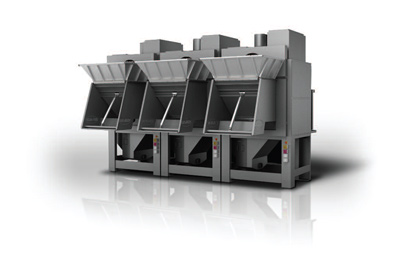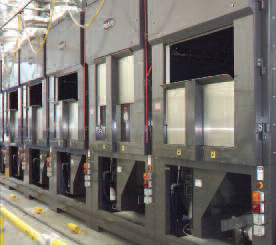Maximizing Productivity in The Washroom
 The industry has made significant strides in the past decade to advance the washroom technologies that are available for either the conventional, or batch tunnel-operating environments. We have seen suppliers maximize the productivity of their equipment while striving to minimize the costs and space required to support the solutions that they have brought to the market. The end result has been more efficient equipment, better designed operating spaces, and a more flexible and dynamic production capability.
The industry has made significant strides in the past decade to advance the washroom technologies that are available for either the conventional, or batch tunnel-operating environments. We have seen suppliers maximize the productivity of their equipment while striving to minimize the costs and space required to support the solutions that they have brought to the market. The end result has been more efficient equipment, better designed operating spaces, and a more flexible and dynamic production capability.
One of the areas that has always presented a challenge to laundries is their ability to realize the production capability of the systems that they already have in place. Often the designed solution starts out with the proper balance of wash, dry, and material handing equipment to ensure a consistent flow of product through the washroom. However, budget cuts, restrictions in the plant infrastructure, and shortcomings in the production planning of the operation result in the plant not realizing its full potential. This statement holds true for manual, semiautomated, and fully automated environments. However, it can actually be more pronounced with the higher level of automation that is installed. This may sound a bit counter intuitive, but when you step back and think about it, these environments are no different than a highperformance team in that it takes all aspects to work in coordination to achieve success. When one area breaks down or falls out of sync with others, efficiency is decreased and results are less than desired.
One of the areas that has always presented a challenge to laundries is their ability to realize the production capability of the systems that they already have in place.
I have spent over 35 years in this industry operating just about every type of plant you can imagine, and operating in all of the various market segments that are served by our industry. I have lived through this evolution of technology, seen some exceptional gains made through its application, and seen where concepts did not materialize to the desired end state. Most recently, I have seen the advent of various solutions to address material handling challenges that exist within our plants. On the Batch Tunnel side of things there has been a need to develop solutions that would allow plants to best utilize space while creating a flexible operating environment. In the last two years I have seen operators who have retooled or built new sites that required the use of multiple tunnels and leveraged a cross conveyor technology. This solution allows the operator to discharge products from the press to a rail system, establish a storage buffer to support down stream processing demands, and to place a conveyor between two dryers that can load either unit. This system also has allowed operators to eliminate the use of shuttles and have greater flexibility in how they lay out their plants.
Most recently, I have seen the advent of a new solution that was developed to further address the needs of end users, and the weaknesses that exist with the cross conveyor approach. This solution places a chute on the face of the dryers that exist within the operating system. What is impressive about this solution is its sheer simplicity. The design is robust, cost effective, and further optimizes the relationship between the rail system and the dryer. As a result, it improves operational turn times, eliminates the liability associated with having to maintain multiple conveyor systems and the productivity loss that is incurred when one of these conveyors fails. What is also interesting about this solution is that it makes even better use of valuable space within the plant. We all know that bricks and mortar are expensive, and that space is a precious commodity.
The design is robust, cost effective, and further optimizes the relationship between the rail system and the dryer.
I have found this solution to be very intriguing when it comes to today’s economic environment. It is ideal for new plants, but the reality is that there aren’t as many new plants being built today. However, there are many plants that are being retooled or facing the need to make a retooling decision. This solution affords the operator the ability to consider making a capital investment in stages, which may be more reasonable for them to undertake. Often the greatest opportunity for an operator to improve its capacity of a tunnel plant is to eliminate dryer hold times, improve drying efficiency, and optimally schedule products through the operating environment. By taking a modular approach to retooling the plant one can cost effectively transform the site and optimize productivity concurrently. An example would be a client who has two tunnel systems that are losing 5-6 transfers each hour due to the problem areas I noted above. By implementing this solution they can virtually eliminate those problem areas and optimize the existing environment. The additional benefit is that they eliminate shuttles and the hazardous motion and safety integration costs associated with protecting shuttle environments. As you can see, this site did not need to replace the entire system to address shortcomings, but instead implemented a buffer system with the rail, and a more efficient drying and material handling solution.
Tunnel plants are not the only ones to benefit from this development. This same solution is easily applied to the conventional automated wash floor, and it provides the same net impact as it does for the batch washing systems. I have only seen two fully automated solutions come to market thus far for the conventional washroom that eliminate the need for shuttles. One utilizes vacuum units from dryers to suck goods to the dryers for processing. These dryers are placed on a mezzanine above the washers. This solution does allow for the elimination of shuttles and many of the integrated safety solutions that are required for the conventional automated wash environment. However, it does not come without its potential drawbacks.
- Infrastructure modifications and the sheer cost associated with installing and maintaining the system.
- Vacuum units by their own nature consume energy; require cleaning and maintenance to ensure proper operation.
- For those who do dry or condition their mats this system will not support such a requirement.
 Again, I applaud the development of this system as it has forced others to look at creative ways to address end user needs, and it has made our industry better as a result.
Again, I applaud the development of this system as it has forced others to look at creative ways to address end user needs, and it has made our industry better as a result.
The chute loaded dryer solution in the conventional washroom does not require extensive infrastructure costs, is a cost effective solution that is virtually maintenance free, and can support the processing of mats for those industrial accounts that may have this need.
It is an exciting time to be in our industry, and it is even more exciting to see solution providers investing in technologies that will help our operators improve their bottom line. In today’s challenging economy everyone is looking for ways to raise the bar on performance and the patent pending chute loading solution allows operators to do so in a cost effective manner.

Joe Grummel
President
Fresh Laundry Concepts